Are you a Quiet Speculation member?
If not, now is a perfect time to join up! Our powerful tools, breaking-news analysis, and exclusive Discord channel will make sure you stay up to date and ahead of the curve.
I’ve been saying for a few weeks now that, since the printing of Blossoming Defense, Infect is far and away the best deck in the format. The addition of yet another pushed pump effect seemed to me to be a strict upgrade to Apostle’s Blessing, an already powerful card in the archetype. While Infect’s weaknesses still remain (a poor matchup in Jund, and an inherent unavoidable inconsistency in deck composition) the archetype has only gotten better recently, while most every other archetype has remained stagnant.
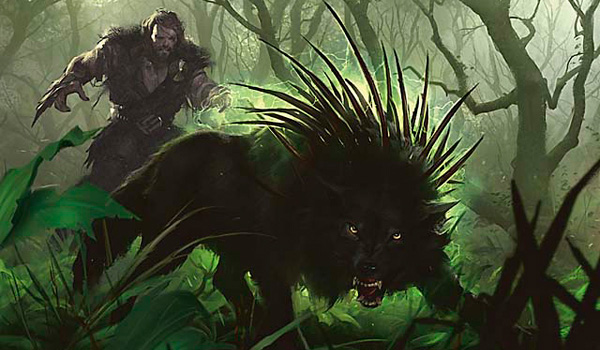
Still, the archetype has only put up results that can best be described as "lukewarm," especially considering the rhetoric surrounding the strategy (thanks in part to me, but attributable to others as well). So, for the past few weeks, I’ve been working on the deck myself, tuning, perfecting, learning the ins and outs. Today, I share my knowledge. Welcome to Infect 101.
[wp_ad_camp_1]
Infect, by Trevor Holmes (5-0, Modern League)
For the most part Infect is still Infect, and hasn’t changed much since the OG version with Ponder and Preordain. Become Immense will go down in history as the inflection point for this archetype, the reinvigoration that elevated it back to Tier 1, but beyond that, everything else has stayed routine for the most part. 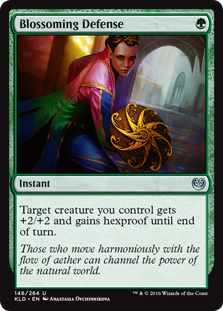 The ability to essentially one-shot our opponent for one mana (given some setup) is excellent, as is the ability to capitalize on a resource that would otherwise be left unutilized (the graveyard). The card isn’t without negatives, as the second copy can often be a dead draw, but for the most part getting a Might of Old Krosa or better at instant speed is the best possible thing we could be doing.
The ability to essentially one-shot our opponent for one mana (given some setup) is excellent, as is the ability to capitalize on a resource that would otherwise be left unutilized (the graveyard). The card isn’t without negatives, as the second copy can often be a dead draw, but for the most part getting a Might of Old Krosa or better at instant speed is the best possible thing we could be doing.
Blossoming Defense is, in my opinion, the second gift (alongside Become Immense) that has finally pushed this archetype firmly in front of the rest of the field. Before Blossoming Defense, Infect had to turn to Apostle's Blessing if they desired more protection effects than the four copies of Vines of Vastwood. In doing so, they diluted the consistency of their deck by trading a pump spell for what is essentially a narrow Spell Pierce. Spell Pierce is great, as the playset in the board can confirm, but it goes against our Plan A and we would much rather be disrupting our opponent with it than using it to protect our own creatures. There are metagames where Spell Pierce is a maindeckable card and even possibly better than a protection effect, but in the abstract, maximizing the percentage of our spells that pump our creatures is where we want to be.
Now, I can anticipate the reaction here, which would go something like this:
“But Apostle's Blessing can Falter blockers! That’s what you’re really losing with Blossoming Defense.”
This is 100% true, and definitely something that would be a mistake to overlook. Blocking isn’t something that’s happening often against our Infect creatures, as Inkmoth Nexus flies and Blighted Agent came prepared, but still happens often enough that we need to have a contingency in place. 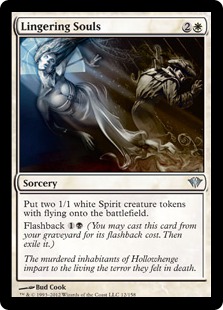 One copy of Lingering Souls is often enough to stall us out for enough turns that opposing removal or counter-threats can take over. Young Pyromancer tokens or even just a Snapcaster Mage can make attacking with Glistener Elf seem like spinning tires. We have methods in place to live through such engagements (exalted, Pendelhaven), but if we’re not doing damage to the player we’re usually losing.
One copy of Lingering Souls is often enough to stall us out for enough turns that opposing removal or counter-threats can take over. Young Pyromancer tokens or even just a Snapcaster Mage can make attacking with Glistener Elf seem like spinning tires. We have methods in place to live through such engagements (exalted, Pendelhaven), but if we’re not doing damage to the player we’re usually losing.
What it comes down to is how many non-pump spells we can afford to run. We can’t cut our Falters completely, and as narrow as Distortion Strike may appear it does a fine job providing us two attacks in one card. That might not seem like much, but two attacks is usually all we’re looking for to kill our opponent, and if we’re facing any sort of board, two turns is often all we’re going to get anyways. Against over half the field we’d much rather have access to Dismember or Spell Pierce, but in the matches where we’re looking for Distortion Strike, it’s often the only unique effect that can save us. So, necessary evil, but I’m only playing the singleton.
Settling on Flex Slots
Infect has around five flex slots that we adjust to whatever we see fit, and then the sideboard which can take one of two approaches based on similar factors. We’ll tackle the maindeck first.
Dismember
Creature removal isn't strictly necessary in Infect, as we’re usually faster than other creature decks besides Burn. Burn is a bad matchup, but it isn't really a creature deck and Dismember isn’t what we want there regardless. 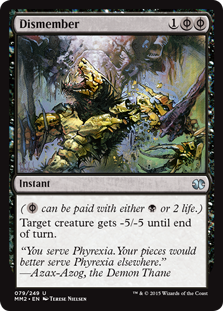 For everyone else, one copy of removal is fine to dig to or hold as insurance. Nabbing a Dark Confidant from Jund, a Tarmogoyf that's beating down, a Narcomeba hanging back to block, or a Thought-Knot Seer sitting on a free card are all solid uses, to say nothing of the mirror. Dismember is fine against Affinity—popping a Cranial Plating-toting attacker or a Steel Overseer before he starts rolling can often swing the race—but we’re not really playing Dismember for this matchup. Out of all the archetypes in the format, we can probably race Affinity in game one the best, but there’s a reason for the three Nature's Claim in the board. Adjusting maindeck numbers to fight an 80/20 game-one deck is defensible in some metagames, but in a field this varied there are bigger fish to fry.
For everyone else, one copy of removal is fine to dig to or hold as insurance. Nabbing a Dark Confidant from Jund, a Tarmogoyf that's beating down, a Narcomeba hanging back to block, or a Thought-Knot Seer sitting on a free card are all solid uses, to say nothing of the mirror. Dismember is fine against Affinity—popping a Cranial Plating-toting attacker or a Steel Overseer before he starts rolling can often swing the race—but we’re not really playing Dismember for this matchup. Out of all the archetypes in the format, we can probably race Affinity in game one the best, but there’s a reason for the three Nature's Claim in the board. Adjusting maindeck numbers to fight an 80/20 game-one deck is defensible in some metagames, but in a field this varied there are bigger fish to fry.
As a final note, if we’re looking for more removal, the second Dismember is probably too expensive. Just because we’re playing two maindeck doesn’t mean we’re always drawing and casting both, as we are really adding the second copy to draw one more often. Just keep in mind that we’re probably taking more damage in game one against the field as most maindeck archetype configurations will be forced to race. Between Dismember, Gitaxian Probe, Mutagenic Growth and our opponent kindly helping, the second Dismember might end up uncastable in our hand. I’ve seen a few other options that all look horrible, but we could do worse than add a maindeck Spellskite to gum up the ground and provide an extra piece of protection. Not to mention the rude game-one mirror bomb potential.
Twisted Image
I went from cutting this card after almost every game one to keeping it in almost all the time. The right play is somewhere in the middle, but I’m still figuring that out. 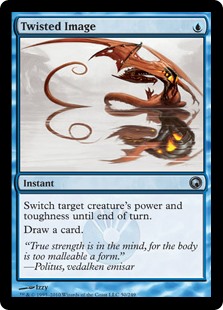 There are fewer Spellskites running around now that Splinter Twin is banned, but they are still out there, and Twisted Image is designed to be functional and never dead. This sounds great in theory, but what do you do in-game, when you haven’t seen a Spellskite yet and are digging for pump (because Twisted Image is taking the place of a pump spell in hand)? Do you cycle it for action, only to be left cold to a Spellskite later in the game? These intricacies are context-dependent and complicated, and to be honest the whole draw to playing the archetype in the first place, besides turn-threeing plebs. So, no, I’m not going to give you the answer.
There are fewer Spellskites running around now that Splinter Twin is banned, but they are still out there, and Twisted Image is designed to be functional and never dead. This sounds great in theory, but what do you do in-game, when you haven’t seen a Spellskite yet and are digging for pump (because Twisted Image is taking the place of a pump spell in hand)? Do you cycle it for action, only to be left cold to a Spellskite later in the game? These intricacies are context-dependent and complicated, and to be honest the whole draw to playing the archetype in the first place, besides turn-threeing plebs. So, no, I’m not going to give you the answer.
Nabbing opposing Noble Hierach, Birds of Paradise, Ornithopter and Signal Pest are great, and drawing a card off the kill just feels dirty. Were it not for the plentiful Affinity targets I could see myself going down to one, but I like having access to a way to kill Spellskite should somebody random like RG Breach decide that they aren’t losing to Infect today. And yes, you can get an extra point of power out of Pendelhaven. Now we’re all pros together.
Wild Defiance
I’ve gone from trying this card, to cutting it, to bringing it back multiple times now. When we stick it against damage-based removal it’s huge, but ever since Blossoming Defense I haven’t had much trouble keeping creatures alive. 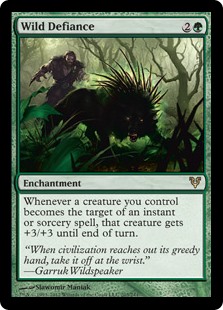 Most of my losses have been to discard, losing races, or Liliana, the Last Hope. Wild Defiance doesn’t help in those situations, as often the mana I’ve spent to cast Wild Defiance was the mana I needed to pump for the win. Remember, every non-pump slows us down, and from my experience Wild Defiance counts as a non-pump the turn it’s played.
Most of my losses have been to discard, losing races, or Liliana, the Last Hope. Wild Defiance doesn’t help in those situations, as often the mana I’ve spent to cast Wild Defiance was the mana I needed to pump for the win. Remember, every non-pump slows us down, and from my experience Wild Defiance counts as a non-pump the turn it’s played.
I’ve got the feeling we want this most against midrange archetypes full of removal and discard, so the one pump spell they leave us with actually ends up being enough to kill them. I know it’s a great card, but we could possibly be in the wrong metagame for it. I’m only playing the singleton, and I would say I’ve boarded it in around 10% of my matches, and drawn it even less. So I can’t have played with it north of ten times by now, even though I’ve played a bunch of matches. Still, the times I’ve cast it, it hasn’t saved me where no other card could.
Kitchen Finks
On the other hand, Kitchen Finks has saved me where no other card could, and I’m loving it. There’s your McDonald’s plug in case you missed it. You may notice there are no Finks in the list above. 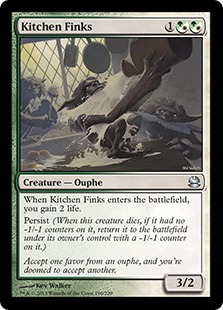 I've been trying lists both with and without the card—the lists with Finks make room for three copies by cutting a Spell Pierce, a Ravenous Trap, and the Wild Defiance.
I've been trying lists both with and without the card—the lists with Finks make room for three copies by cutting a Spell Pierce, a Ravenous Trap, and the Wild Defiance.
Aside from Burn (where it’s great, but we’re not talking about Burn in this metagame) the lifegain is welcome for Affinity, Dredge, and even Eldrazi. Nothing stops a race like Kitchen Finks, and on top of everything we get to give Jund fits. I’ve brought this in against almost everyone, even in the mirror against an Infect opponent with what seemed like a ton of Apostle's Blessing and Dismember in game one. With so much random pump, we can get the “hard way” kill more often than you would think, and having another creature with actual printed power besides Dryad Arbor can help us get there. Kitchen Finks gives us options, it gives us blockers, and it gives us more guys for the red zone.
Conclusion
Infect is a deceitful archetype, in the sense that it looks relatively the same on the surface, but 20 cards (5 maindeck, 15 sideboard) can influence matchups greatly. Spotting the difference in numbers, and discovering how they affect various results is an acquired taste, and one I’m just now starting to get the hang of.
Decklist analysis is important, but nowhere near as influential as play familiarity. Around 80% of your mileage out of Infect comes from in-game decisions, not deck composition. Results may vary, and I implore readers looking to pick up the archetype to put in the work. I’ve been playing steadily for about a month now, and I suffered through a few 2-3s and 3-2s while I got my bearings.
Points can be lost in areas that aren’t immediately apparent, so pay close attention to results and what you could have done to change things. While I rarely use the MTGO replay feature, I’ve found myself turning to it with this archetype, to uncover lines I might have missed and visualize results had I taken a different fork. While I’ll eventually put Infect down in favor of other decks, familiarizing myself with the lines and capabilities will definitely help me down the line when I find myself on the other side of the table. If you plan on picking it up, good luck!
Trevor Holmes
The_Architect on MTGO
Twitch.tv/Architect_Gaming
Twitter.com/7he4rchitect




Hey Trevor, I see you’ve found a new deck to feature for us. Everything in it looks pretty good. My question is, why are we not talking about Burn in this metagame? It seems to be doing pretty well from what I can tell. Is it because the matchup is bad for Infect pretty much no matter what?
Roland,
I’m of the very biased opinion that Burn can’t be taken seriously in the metagame while Dredge is around in large numbers. This thinking might not be as universal as I think it is, so I possibly should have mentioned that in the article. I’m not entirely sure what the public consensus is regarding Burn, from the discussions I’ve had and what I’ve seen in the community for the past few weeks it seems that the “Burn is bad while Dredge is good” thinking is common, but again, that doesn’t stop a player from picking up Burn and doing well with it regardless.
Hope that helps?
Trevor
I think that’s somewhat myopic, to be frank. Burn may not have the best Dredge matchup, but it’s not a terrible one, and they can pack hate just as easily as any other deck. When we look beyond that, we also see a deck that pummels Death’s Shadow, Infect, Lantern Control, and Tron (which are doing stuff right now), and can hang with the likes of Bant Eldrazi and BGx, which constitutes the majority of the Tier 1 metagame at the moment. If Ad Nauseam and Dredge are its only commonly played bad matchups (and the latter can be mitigated through hate), I’d say Burn’s in a pretty good place right now.
A kitten dies every time someone says “strict upgrade” when what they actually mean is just “upgrade”, leaving themselves with no relevant language for something that really IS a “strict upgrade”.
Got me, I guess. ‘Strict upgrade’ for you is like ‘gunslinging’ for me. Hope you made it past the first paragraph!
While the term is a colloquialism, I do see a difference between the two. Blossoming Defense does what Apostle’s Blessing does 80% of the time but better, so it is a ‘strict upgrade’. Something else like Might of Old Krosa vs. Groundswell is just an ‘upgrade’, as they do similar things but different enough that they can’t be compared on the exact same metric.
Not sure if wanted an elaboration, but there it is 🙂